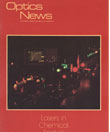
October, 1986 Issue
Feature Articles
Laser ionization mass spectrometry in supersonic beams
Mass spectrometry still remains one of the most powerful means of chemical analysis based upon the exact mass identification of molecular species. This identification may be based upon the parent ion or extensive fragmentation patterns induced by electron beam or collision induced phenomena. For analysis of mixtures of compounds generally tandem methods must be employed to obtain sufficient discrimination for identification in mass spectrometry.
by Roger Tembreull, Chung Hang Sin, Ho Ming Pang, and David M. LubmanLaser applications to materials and surface analysis
Resonance ionization spectroscopy (RIS) is a method of analysis in which narrow-band lasers are used to ionize elements selectively and efficiently. It is the basis for several ultrasensitive elemental analysis techniques, one of which is called sputter initiated resonance ionization spectroscopy (SIRIS), now being used for materials and surface analysis.
by James E. ParksThe Kerr effect
In 1875, the Scotsman John Kerr discovered that transparent, amorphous substances, such as glass and many liquids, become doubly refracting while subjected to a strong electric field.1 This phenomenon became the basis for the construction of optically bistable devices and ultrafast optical shutters, and it has become valuable in the study of molecular structure and dynamics.
by Bruce A. GaretzPhotothermal methods for detection of molecules in liquids
Photothermal spectroscopic methods are based on detecting the heat deposited in a sample by absorption of radiation and subsequent nonradiative relaxation of the excited states produced.
by Joel M. Harris
![Illustration of optical skyrmions. [Y. Shen]](https://opnmedia.blob.core.windows.net/$web/opn/media/images/articles/2025/0525/departments/202505-cover-web.jpg?ext=.jpg)
![Illustration of a synapse in the brain. [Getty Images]](https://opnmedia.blob.core.windows.net/$web/opn/media/images/articles/2025/0425/departments/202504-cover-web.jpg?ext=.jpg)
![Fiber draped around a hand, demonstrating its flexibility. [Photo by Z. Wang and L. Wei]](https://opnmedia.blob.core.windows.net/$web/opn/media/images/articles/2025/0325/departments/202503-cover-web.jpg?ext=.jpg)